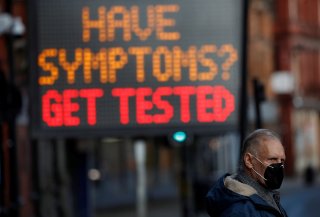The End of the Pandemic Is Coming – Just Don’t Set a Date for the Party
The virus won't be dealt with evenly throughout the world. It could still come back.
“After the pandemic is over” must be one of the most frequently uttered phrases of 2021. I am certainly guilty of this kind of optimism, longing for the day when I can get on a plane, have dinner with my friends, and cuddle all the new babies I know who have been born under the restrictive eye of COVID-19.
In February, the UK government unveiled a four-step plan to ease England’s lockdown restrictions by June 21. While the prime minister has cautioned that the country’s path out of the pandemic will be driven by “data not dates”, his restraint has had little impact, it seems, on the population’s excitement levels. Memes and social media posts immediately proliferated, with people booking flights, planning parties, and taking time off work in anticipation of future freedom.
Looking ahead to the end of the pandemic is not confined to the UK, and as the vaccine rollout proceeds (albeit unevenly), people across the world are turning their attention to celebration and relief. However, history tells us that the end of pandemics are rarely – if ever – neat, uncomplicated, or even easy to date.
Past Pandemics
The misleadingly named Spanish flu pandemic of 1918 was the deadliest in history. It infected around 500 million people worldwide and killed anywhere from 20 million to 50 million. Much like today, citizens were subjected to social restrictions and ordered to wear masks. The pandemic abated, but identifying its precise end is almost impossible.
In 1920, several newspapers reported the reappearance of influenza. Around 5,000 cases were reported in Chicago in the space of six days, and theatres were ordered to close. Later that year, “drastic measures” were implemented to check the spread of flu in New York City after an emergency meeting of the transportation authorities, theatre and cinema owners, and the representatives of department stores. At around the same time, 60 people died from influenza in Paris.
Subsequent waves of the virus ripped through European and North American cities for years after the pandemic’s supposed end. As late as 1925, and in the space of nine days, 201 people in Chicago died from what the newspapers called a “highly contagious influenza epidemic”. It is hardly surprising, therefore, that there is little evidence in the historical record of parties to commemorate the end of the terrible virus.
Today’s coronavirus pandemic is, of course, different to the march of influenza around the globe in 1918 – not least because we have several highly effective vaccines. The jab is a powerful tool and so many people’s hopes for COVID’s end hang on this marvellous technology. However, while vaccines have played a crucial role in past efforts to control infectious disease, their ability to bring pandemics to a rapid and definitive close is much more limited.
Take polio, for example. A vaccine was developed for the disease in the 1950s. Its inventor Jonas Salk became an almost immediate American hero, but it took almost three decades for polio to be brought under control in Britain and there were no celebratory holidays marking the last naturally acquired infection in 1984.
The End of Fear
Historians of medicine know that pandemics and epidemics are social phenomena. As a result, their endings happen in two ways. There is the medical conclusion of a pandemic, when disease incidence goes down and death rates plummet. But there is also the social end, when fear of the infection decreases and social restrictions ease.
Crucially, you can have one without the other. The rates of coronavirus might go down, fewer people will be hospitalised and die, people’s anxieties could ease, and life could return to normal – in that order. Or rates could stay the same, but people just get sick and tired of restrictions and launch themselves into the parties they had planned, regardless. Or rates could go down, but people remain fearful – anxious about returning to “normal life” and unable to let go of some of the precautions we have become accustomed to.
We also have to remember that coronavirus is a global disease and that different places will have varying social and medical conclusions to their respective versions of the pandemic.
Uneven Geography
HIV/AIDS swept through Europe and North America in the 1980s and 90s. Infection rates have since dropped dramatically, and many HIV-positive people live long and healthy lives in developing countries. And yet, as of 2019, almost 40 million people are infected with HIV worldwide and we are still experiencing what the World Health Organization calls a “global epidemic”, it is just that the geographical scope of the disease has shifted.
As wealthier nations continue to vaccinate themselves out of restrictions, the ending of their pandemics might come relatively quickly. But what about the rest of the world? When will developing countries see a similar conclusion?
Wherever you look, there is unlikely to be a precise end date for the pandemic. We have only managed to successfully eradicate one disease (smallpox), and for every other epidemic or pandemic in history, their endings have been messy, protracted, and uneven. While we all might need a dose of optimism, rather than planning parties or holidays, perhaps our time now would be better spent thinking about what kind of future we want to look forward to and how we put the lessons we have learned this past year into practice.
Agnes Arnold-Forster is a Researcher on the History of Medicine and Healthcare at the University of Bristol.
This article first appeared at The Conversation and is being republished via a Creative Commons license.

